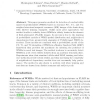Free Online Productivity Tools
i2Speak
i2Symbol
i2OCR
iTex2Img
iWeb2Print
iWeb2Shot
i2Type
iPdf2Split
iPdf2Merge
i2Bopomofo
i2Arabic
i2Style
i2Image
i2PDF
iLatex2Rtf
Sci2ools
112
Voted
IPMI
2009
Springer
2009
Springer
Fully-Automated White Matter Hyperintensity Detection With Anatomical Prior Knowledge and Without FLAIR
This paper presents a method for detection of cerebral white matter hyperintensities (WMH) based on run-time PD-, T1-, and T2weighted structural magnetic resonance (MR) images of the brain along with labeled training examples. Unlike most prior approaches, the method is able to reliably detect WMHs in elderly brains in the absence of fluid-attenuated (FLAIR) images. Its success is due to the learning of probabilistic models of WMH spatial distribution and neighborhood dependencies from ground-truth examples of FLAIR-based WMH detections. These models are combined with a probabilistic model of the PD, T1, and T2 intensities of WMHs in a Markov Random Field (MRF) framework that provides the machinery for inferring the positions of WMHs in novel test images. The method is shown to accurately detect WMHs in a set of 114 elderly subjects from an academic dementia clinic. Experiments show that standard off-the-shelf MRF training and inference methods provide robust results, and that increasi...
FLAIR-based WMH Detections | IPMI 2009 | Medical Imaging | Off-the-shelf Mrf Training | WMH Spatial Distribution |
| Added | 17 Nov 2009 |
| Updated | 17 Nov 2009 |
| Type | Conference |
| Year | 2009 |
| Where | IPMI |
| Authors | Charles DeCarli, Christopher Schwarz, Evan Fletcher, Owen T. Carmichael |
Comments (0)

